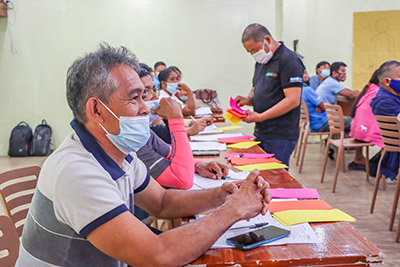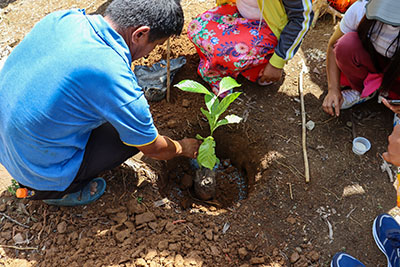 |
 |
As Mindanao holds the title of having the largest coffee production in the Philippines, the Department of Agriculture-Philippine Rural Development Project (DA-PRDP) in partnership with the High-Value Crops Development Program (HVCDP) immersed 20 Caraga coffee farmers into a 3-day training conducted by the Philippine Coffee Advancement and Farm Enterprise Project (PhilCAFE) on August 4-6.
Trained as coffee mentors, these farmers are expected to extend knowledge on Coffee Production, Farm Management, Integrated Pest and Disease Management, and Rejuvenation of Robusta to fellow farmers in Tungao, Butuan City, Cabadbaran City, and Las Nieves, Agusan del Norte; Bayugan City and Esperanza, Agusan del Sur.
Farmers were equipped with the Good Agricultural Practices (GAP) of Robusta to increase the variety’s national production average from .5-MT/ha to 1-MT/ha, making the Philippines coffee-sufficient. In Caraga Region, around 4,740 were planted with Coffee.
PhilCAFE Regional Coordinator Ludovico Ramirez Jr. highlighted that the training promotes site-specific practices which only endorse Robusta production as the ideal coffee variety in Caraga. He covered most of the topics including Coffee Establishment, Care, and Maintenance; Factors Influencing Coffee Yield and Quality; Site Preparation and Field Planting.
“As the next trainers, you should be a model of the GAP. Farmers would not instantly believe in these new practices, so you should show them by actually doing it and making them see the benefits and improvement of applying GAP,” Ludovico said.
Aside from production, Ludovico also encouraged farmers to see coffee as a potential business enterprise, teaching them how to harvest excellent Robusta coffee beans for a higher market value. Liquidating farm expenses and operations even from the smallest details was also stressed out.
An actual field activity in Simbalan, Agusan del Norte let farmers experience an actual demonstration of the proper coffee planting, rejuvenation, care, and maintenance of coffee. They also collected pests and diseases in the area and prepared a bio-control agent for coffee pests such as the white muscardine fungus.
PRDP’s Proponent Group signs up
Participants come from various cooperatives in Caraga including the PRDP Enterprise Proponent Group, Casiklan Wheels Farmers Association Inc (CAWFAI).
Rogelio O. Estodillo, CAWFAI Chairperson pointed out that the training has introduced them to a deeper knowledge of Robusta coffee production which will be helpful to their soon Green Coffee Bean Production and Marketing Project.
“As soon as I go back to my hometown, I will apply the things that I have learned in the training, especially now that my coffee is in the stage of rejuvenation. Through this, my fellow farmers will see the difference between the old practices and the good agricultural practices taught here. As a coffee mentor, I will teach them while being a model to them,” said Estodillo.
Farmers presented a re-entry plan which covered an activity design on how and when they will conduct a re-echo training to their community.
Robusta coffee only for Caraga
Among the four coffee varieties in the Philippines, PhilCAFE emphasized that Robusta coffee is the best choice to plant in Caraga. It is ideal in elevations 200 to 900m above sea level since it’s less vulnerable to pests and weather conditions. Unlike Arabica coffee, Robusta can grow in direct sunlight.
Robusta is also the highest coffee produced in the Philippines which accounts 72.7% of the total production based on the 2021 Philippines Statistics Authority. Mindanao makes 80% of Robusta along SOCCSKSARGEN as the top producer with a 36% share. Robusta is mainly used in instant coffee and brewing. (Zenny G. Awing / DA-PRPD13)






